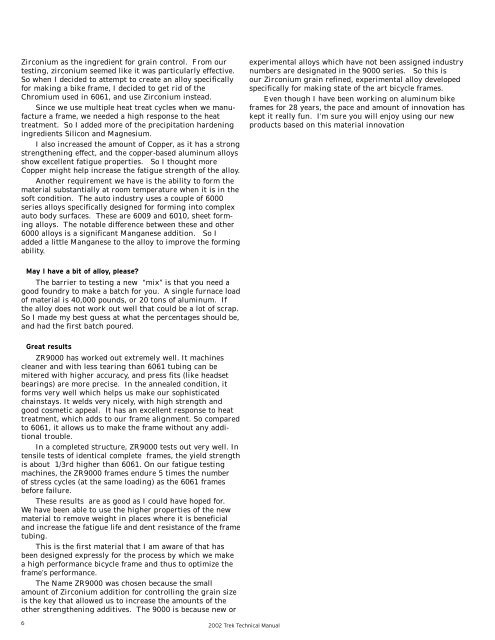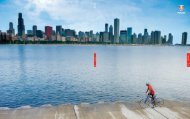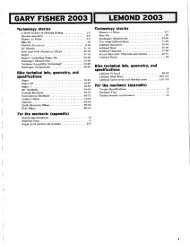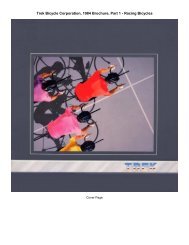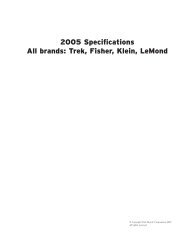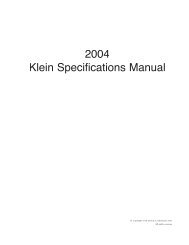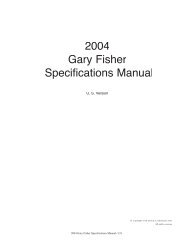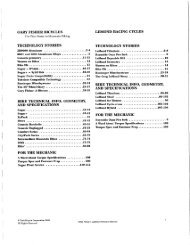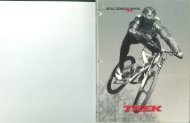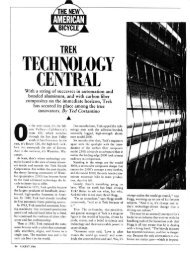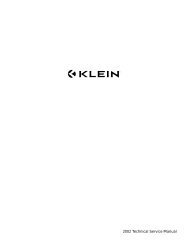TECHNOLOGY STORIES BIKE INFO, GEOMETRY ... - Vintage Trek
TECHNOLOGY STORIES BIKE INFO, GEOMETRY ... - Vintage Trek
TECHNOLOGY STORIES BIKE INFO, GEOMETRY ... - Vintage Trek
Create successful ePaper yourself
Turn your PDF publications into a flip-book with our unique Google optimized e-Paper software.
Zirconium as the ingredient for grain control. From our<br />
testing, zirconium seemed like it was particularly effective.<br />
So when I decided to attempt to create an alloy specifically<br />
for making a bike frame, I decided to get rid of the<br />
Chromium used in 6061, and use Zirconium instead.<br />
Since we use multiple heat treat cycles when we manufacture<br />
a frame, we needed a high response to the heat<br />
treatment. So I added more of the precipitation hardening<br />
ingredients Silicon and Magnesium.<br />
I also increased the amount of Copper, as it has a strong<br />
strengthening effect, and the copper-based aluminum alloys<br />
show excellent fatigue properties. So I thought more<br />
Copper might help increase the fatigue strength of the alloy.<br />
Another requirement we have is the ability to form the<br />
material substantially at room temperature when it is in the<br />
soft condition. The auto industry uses a couple of 6000<br />
series alloys specifically designed for forming into complex<br />
auto body surfaces. These are 6009 and 6010, sheet forming<br />
alloys. The notable difference between these and other<br />
6000 alloys is a significant Manganese addition. So I<br />
added a little Manganese to the alloy to improve the forming<br />
ability.<br />
May I have a bit of alloy, please?<br />
The barrier to testing a new “mix” is that you need a<br />
good foundry to make a batch for you. A single furnace load<br />
of material is 40,000 pounds, or 20 tons of aluminum. If<br />
the alloy does not work out well that could be a lot of scrap.<br />
So I made my best guess at what the percentages should be,<br />
and had the first batch poured.<br />
Great results<br />
ZR9000 has worked out extremely well. It machines<br />
cleaner and with less tearing than 6061 tubing can be<br />
mitered with higher accuracy, and press fits (like headset<br />
bearings) are more precise. In the annealed condition, it<br />
forms very well which helps us make our sophisticated<br />
chainstays. It welds very nicely, with high strength and<br />
good cosmetic appeal. It has an excellent response to heat<br />
treatment, which adds to our frame alignment. So compared<br />
to 6061, it allows us to make the frame without any additional<br />
trouble.<br />
In a completed structure, ZR9000 tests out very well. In<br />
tensile tests of identical complete frames, the yield strength<br />
is about 1/3rd higher than 6061. On our fatigue testing<br />
machines, the ZR9000 frames endure 5 times the number<br />
of stress cycles (at the same loading) as the 6061 frames<br />
before failure.<br />
These results are as good as I could have hoped for.<br />
We have been able to use the higher properties of the new<br />
material to remove weight in places where it is beneficial<br />
and increase the fatigue life and dent resistance of the frame<br />
tubing.<br />
This is the first material that I am aware of that has<br />
been designed expressly for the process by which we make<br />
a high performance bicycle frame and thus to optimize the<br />
frame’s performance.<br />
The Name ZR9000 was chosen because the small<br />
amount of Zirconium addition for controlling the grain size<br />
is the key that allowed us to increase the amounts of the<br />
other strengthening additives. The 9000 is because new or<br />
6<br />
2002 <strong>Trek</strong> Technical Manual<br />
experimental alloys which have not been assigned industry<br />
numbers are designated in the 9000 series. So this is<br />
our Zirconium grain refined, experimental alloy developed<br />
specifically for making state of the art bicycle frames.<br />
Even though I have been working on aluminum bike<br />
frames for 28 years, the pace and amount of innovation has<br />
kept it really fun. I’m sure you will enjoy using our new<br />
products based on this material innovation


